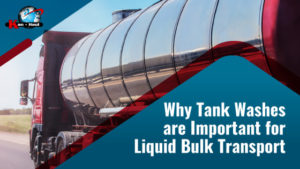June 18, 2021
Why Tank Washes are Important for Liquid Bulk Transport and How they are Performed
 When you are shipping food or liquid in a bulk transporter, it is important to ensure that your tank is kept clean and clear. At Kan-Haul, we believe that going above and beyond to ensure safety should be the most important value we have. We will tell you why and how you can keep your bulk transporter clean and up to inspection standards.
When you are shipping food or liquid in a bulk transporter, it is important to ensure that your tank is kept clean and clear. At Kan-Haul, we believe that going above and beyond to ensure safety should be the most important value we have. We will tell you why and how you can keep your bulk transporter clean and up to inspection standards.
Reasons Why Tank Washes Are Important
There are three main reasons you need to keep your bulk transport tank clean: contamination, bacterial growth, and failed inspections. All three of these can easily be avoided if you clean your tank.
1. Contamination
When chemicals and other types of bulk liquids become exposed to one another, cross-contamination will occur. All it takes is a small trace of the tank’s previous product for that to happen, which has a negative impact on the next product being loaded or even the consumer.
Cross-contamination multiplies the possibility of a consumer coming into contact with food they should not have, whether because of their beliefs, their religion, or an allergy. Not cleaning your tank could be offensive to a consumer or even life-threatening for someone with an allergy. Even the slightest trace of another food could cause an allergic reaction.
2. Bacterial Growth
If contamination occurs because of improper care, bacteria can grow inside the tank. This can cause new products to go bad if not taken care of and disinfected and will cost the shipper and your company money and time. Much like contamination, bacteria could also put the consumer’s health at risk.
3. Failed Inspections
Failure to clean your tank can result in a failed inspection when that time comes. When guidelines aren’t followed and inspections are failed due to contamination and bacteria growth, not only will this delay and hurt you, but it will do the same to the company you are providing the shipping for. Too many failed inspections may cause your company to look bad, which in turn could make your company lose business.
How a Bulk Transporter Tank Is Washed
Your tank will need to be cleaned as soon as the product is delivered to its destination before another product can be placed in the tank. Tank wash facilities are located all over North America and will wash out the tank for you.
Most washes can have an average time ranging from two to three hours. Although it is a long process and can be time-consuming, the effects and reasonings behind it are necessary. There are a few different ways tanks can be cleaned depending on what is being shipped before and after the cleaning. By seeing the type of processes, you can figure out what works best for you. Some of these include:
- Caustic Soda Solution: The most common type of tank wash. This is commonly used for latex products.
- Food-Grade Detergent: Used specifically for food-grade washes.
- Kosher-Certified Materials: Used only for Kosher washes.
- Steam and Rinse: Normally used for alcohols.
- “Pre-Cleaning:” Normally done on products that tend to stick on the inside of the truck. With this, a cleaner gets put onto the tank to loosen up particles before other washes.
After the certain wash is performed, some trailers may require another round of cleaning to be done. In addition to these cleaning agents and processes, some companies may have their own set of rules and guidelines you may need to adhere to, as well. These can include the type of cleaning that must be performed, as well as, the specific facilities that can perform washes on their tanks.
Equipment Used for a Tank Wash
Learning how a bulk tank wash is performed is just one part of the process. The equipment that you use is another. While a tank can be cleaned by hand, a more efficient option is to use a clean-in-place process or a CIP. These are drop-in sprayer devices made for cleaning food-grade tanks:
1. TS-4 Tanker Spray Washer
This CIP cleans up to 44 feet in length with a spray ball and two high-impact nozzles that spray the top of the tank with cleaning solution and then moves down the sides, removing any leftover particles.
2. TS-5 Sani-Matic
This cleans tanks up to 50 feet in length, using a rotation drop-in spray device. The cleaning agent is poured into the TS-5, which is put through the dome of the tank. As the machine spins in a circle, it doses the tank in the cleaning agent, allowing direct cleaning solution delivery to all surfaces in the tank.
Finally, once the tank is cleaned, it can be rinsed, drained, and dried.
Cleaning Is Key for This job
Having a clean and sanitized tank that adheres to our safety standards may only seem like part of the job. However, adhering to our safety standards protects not only you and your company but the consumers of our carried products as well.
Contact Kan-Haul to learn about how you can ensure reliability without worry for your liquid bulk transport tanks.
